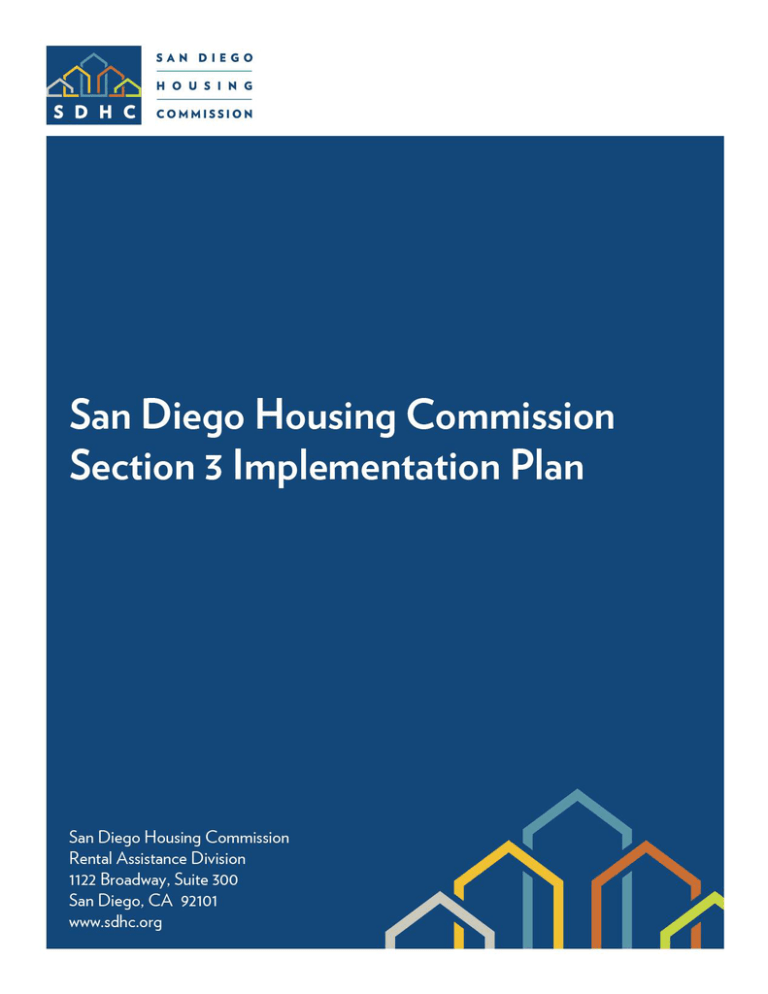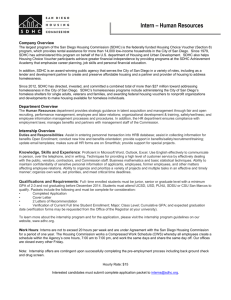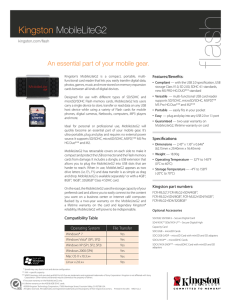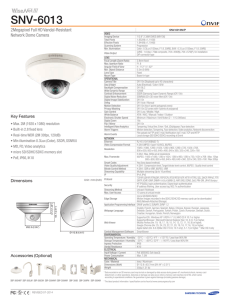Section 3 Implementation Plan - San Diego Housing Commission
advertisement

Effective: 09/16/13 Section 3 Implementation Plan Page 0 of 13 Table of Contents 1. Executive Summary .............................................................................................................................. 2 2. Introduction .......................................................................................................................................... 4 3. Applicability .......................................................................................................................................... 5 4. SDHC Section 3 Unit ............................................................................................................................. 5 5. Compliance ........................................................................................................................................... 5 6. Economic Opportunities for Section 3 Business Concerns.................................................................. 6 6.1. Section 3 Certification Program .................................................................................................... 6 6.2. Contracting.................................................................................................................................... 6 6.2.1. Section 3 Language (Certification of Compliance) ................................................................ 7 6.2.2. Section 3 and Equal Opportunity Contracting Project Utilization Plan................................. 7 6.2.3. Approved Plan Approach ...................................................................................................... 7 6.3. 7. Efforts to Award Contracts to Section 3 Business Concerns ......................................................... 8 6.3.1. SDHC Procurement Department ........................................................................................... 8 6.3.2. SDHC Real Estate Division ..................................................................................................... 8 6.3.3. SDHC Section 3 Unit .............................................................................................................. 9 Economic Opportunities for Section 3 Residents .............................................................................. 10 7.1. Section 3 Certification Program .................................................................................................. 10 7.2. Efforts to Offer Training and Employment Opportunities to Section 3 Residents ..................... 10 7.2.1. SDHC Workforce and Economic Development Department .............................................. 10 7.2.2. SDHC Human Resources Department ................................................................................. 11 7.2.3. SDHC Section 3 Unit ............................................................................................................ 11 8. Providing Other Economic Opportunities ......................................................................................... 12 9. Monitoring Compliance...................................................................................................................... 12 9.1. SDHC Section 3 Unit .................................................................................................................... 12 9.2. SDHC Labor and Contracts Compliance Unit .............................................................................. 13 Effective: 09/16/13 Section 3 Implementation Plan Page 1 of 13 1. Executive Summary Section 3 is a federally mandated program of the U.S. Department of Housing and Urban Development (HUD). Under Section 3 of the HUD Act of 1968, employment and other economic opportunities generated by certain HUD financial assistance shall, to the greatest extent feasible, and consistent with existing Federal, State and local laws and regulations, be directed to low- and very low-income persons, particularly those who are recipients of government assistance for housing, and to business concerns which provide economic opportunities to low- and very low-income persons As a public housing agency and recipient of housing and community development assistance from HUD, the San Diego Housing Commission (SDHC) is required to develop and implement a Section 3 Program that complies with the HUD Act and its implementing regulations, located in Part 135 of Title 24 of the Code of Federal Regulations (24CFR135). SDHC is committed to complying with Section 3 in its own operations and ensuring the compliance of its sub-recipients, contractors and subcontractors. The SDHC Section 3 Unit consists of two full-time staff members—a Program Manager and a Program Analyst. The SDHC Section 3 Unit’s responsibilities include, but are not limited to, the following: Implementing Section 3, Ensuring Section 3 compliance, Monitoring Section 3 compliance, and Providing technical and outreach assistance. Section 3 is implemented in two phases. The first phase comprises developing the necessary infrastructure—the procedures and tools needed to ensure standardized operations within SDHC, and guidelines for developers, contractors and subcontractors. The second phase comprises training, outreach and recruitment. Section 3 compliance is demonstrated by committing to the following numerical goals: Employing Section 3 Residents as 30 percent of all new hires during a one-year period of the project (i.e., A construction contractor hires 10 new workers; 3 of the new workers should be Section 3 Residents). Contracting: A. Awarding Section 3 Business Concerns at least 10 percent of the total contract dollar amount for construction or rehabilitation services; and B. Awarding Section 3 Business Concerns at least 3 percent of the total contract dollar amount for nonconstruction services. SDHC utilizes three primary tools to facilitate awarding Section 3 Business Concerns at least 10 percent of the total value of construction-related contracts and 3 percent of all other Section 3 covered contracts: 1. Section 3 Language (Certification of Compliance); Effective: 09/16/13 Section 3 Implementation Plan Page 2 of 13 2. Section 3 and Equal Opportunity Contracting Project Utilization Plan; and 3. Approved Plan Approach. Internal and external resources are leveraged to ensure Section 3 Residents are employed as 30 percent of new hires, and that developers, contractors and subcontractors also comply with Section 3. The strategy to offer training and employment opportunities is threefold: 1. Training and Recruiting Collaborate with the SDHC Workforce and Economic Development Department to train and/or recruit Section 3 Residents. Partner with local job training organizations/career centers to train and/or recruit Section 3 Residents. 2. Certifying Section 3 Residents. 3. Notifying qualified Section 3 Residents of employment and training opportunities with SDHC, its developers, contractors and subcontractors. Implementation and compliance of Section 3 is an agency-wide effort led by the SDHC Section 3 Unit. Key SDHC departments/unit supporting this effort are: Workforce and Economic Development, Human Resources, Procurement, Real Estate Division, and Labor and Contract Compliance Unit. Effective: 09/16/13 Section 3 Implementation Plan Page 3 of 13 2. Introduction SDHC is committed to implementing and complying with Section 3 within its own operations and ensuring the compliance of its developers, contractors and subcontractors. The Section 3 Implementation Plan outlines the activities that SDHC will undertake to provide economic opportunities to Section 3 Residents and Section 3 Business Concerns. Under Section 3 of the HUD Act of 1968, employment and other economic opportunities generated by certain HUD financial assistance shall, to the greatest extent feasible, and consistent with existing Federal, State and local laws and regulations, be directed to low- and very low-income persons, particularly those who are recipients of government assistance for housing, and to business concerns which provide economic opportunities to low- and very low-income persons. Section 3 is implemented and regulated by Part 135 of Title 24 of the Code of Federal Regulations (24CFR135). SDHC implements Section 3 in two phases: Phase 1 In the first phase, SDHC develops the necessary infrastructure needed to implement Section 3 and ensure compliance. This requires drafting administrative procedures and forms to be used by SDHC, its developers, contractors and subcontractors. SDHC developed the following user guides to facilitate Section 3 implementation and compliance: Section 3 Administrative Guide—standardizes the administrative procedures within SDHC. Section 3 Contractor’s Guide—addresses Section 3 applicability, the Section 3 Business Concern certification, doing business with SDHC, requirements for proposers/bidders, requirements for awardees, and filing complaints. Section 3 Resident Certification FAQ—provides responses to individuals’ frequently asked questions regarding the Section 3 Resident certification program. Phase 2 The second phase consists of training—both internal and external—to educate SDHC departments and local organizations about Section 3. The internal training is designed to assist SDHC departments in understanding the applicability of Section 3 to their respective operations, and the importance of Section 3 to SDHC. In addition, SDHC educates targeted local organizations. SDHC leverages key divisions and/or departments to recruit residents who currently receive services from SDHC and qualify for Section 3. External outreach involves establishing informal and/or formal partnerships with other public agencies and/or organizations that administer business development and/or job training programs, especially those that target low-income individuals and/or disadvantaged businesses to recruit and certify as Section 3 Business Concerns or as Section 3 Residents. Collaboration is the key to successful implementation and compliance of Section 3. Led by the newly reorganized SDHC Section 3 Unit, SDHC departments leverage one another to achieve desired outcomes; Effective: 09/16/13 Section 3 Implementation Plan Page 4 of 13 and the SDHC Section 3 Unit takes a hands-on approach with developers, contractors and subcontractors. 3. Applicability Section 3 requirements apply to recipients and sub-recipients of Section 3 covered assistance, including contractors and subcontractors that perform on Section 3 covered contracts/projects. The following are types of Section 3 covered assistance: Public and Indian Housing Assistance o Operating Fund o Capital Fund o Development Assistance Housing and community development assistance expended for housing rehabilitation, housing construction, or other public construction Refer to the Section 3 Administrative Guide for a current listing of the types of Section 3 covered housing and community development assistance (when expended for housing rehabilitation, housing construction or other public construction). Section 3 requirements are triggered when there is a need for new hires, contractors and/or subcontractors on Section 3 covered assistance, contracts and/or projects. Section 3 requirements apply to service contracts only. SDHC is a recipient of Public and Indian Housing Assistance and a recipient and/or sub-recipient of housing and community development assistance. 4. SDHC Section 3 Unit The SDHC Section 3 Program is led by the SDHC Section 3 Unit. The SDHC Section 3 Unit consists of two full-time staff members—a Program Manager and a Program Analyst. The SDHC Section 3 Unit’s responsibilities include, but are not limited to, the following: Implementing Section 3, Ensuring Section 3 compliance, Monitoring Section 3 compliance, and Providing technical and outreach assistance. 5. Compliance Numerical Goals Section 3 regulations provide that SDHC, its sub-recipients, contractors and subcontractors demonstrate compliance by committing to the following numerical goals: Effective: 09/16/13 Section 3 Implementation Plan Page 5 of 13 Employing Section 3 Residents as 30 percent of all new hires during a one-year period of the project (i.e., A construction contractor hires 10 new workers; 3 of the new workers should be Section 3 Residents). Contracting: A. Awarding Section 3 Business Concerns at least 10 percent of the total contract dollar amount for construction or rehabilitation services; and B. Awarding Section 3 Business Concerns at least 3 percent of the total contract dollar amount for nonconstruction services. Numerical goals shall be maintained throughout the life of the contract or project. 6. Economic Opportunities for Section 3 Business Concerns 6.1. Section 3 Certification Program SDHC administers a Section 3 certification program for businesses that qualify as Section 3 Business Concerns. A Section 3 Business Concern means a business concern: 1. That is 51 percent or more owned by section 3 residents; or 2. Whose permanent, full-time employees include persons, at least 30 percent of whom are currently section 3 residents, or within three years of the date of first employment with the business concern were section 3 residents; or 3. That provides evidence of a commitment to subcontract in excess of 25 percent of the dollar award of all subcontracts to be awarded to business concerns that qualify via the Section 3 ownership or workforce criterion. Applicants self-certify their Section 3 eligibility by completing a short application that captures industry data, licenses/certifications held and financial capacity. Business concerns that are located in the County of San Diego are eligible for Section 3 certification. The certification program is instrumental to Section 3 implementation and enables SDHC to: Develop and maintain a registry of Section 3 Business Concerns to refer for contracting opportunities; Identify and address the training needs of Section 3 Business Concerns; and Capture, track and report Section 3 Business Concerns’ economic development. 6.2. Contracting SDHC utilizes three primary tools to facilitate awarding Section 3 Business Concerns at least 10 percent of the total value of construction-related contracts and 3 percent of all other Section 3 covered contracts: 1. Section 3 Language (Certification of Compliance); 2. Section 3 and Equal Opportunity Contracting Project Utilization Plan; and 3. Approved Plan Approach. Effective: 09/16/13 Section 3 Implementation Plan Page 6 of 13 6.2.1. Section 3 Language (Certification of Compliance) The Section 3 Language is the standard language that is included in all Section 3 covered Requests for Proposal (RFP), Invitations for Bid (IFB), Invitations for Qualification (IFQ), Notices of Funding Availability (NOFA), and other forms of solicitation for Section 3 covered assistance, agreements, contracts or projects. It provides an overview of Section 3, the requirements for proposers/bidders, the requirements for awardees, and the Section 3 Clause (24CFR135.38). 6.2.2. Section 3 and Equal Opportunity Contracting Project Utilization Plan All proposals/bids must contain a completed Section 3 and Equal Opportunity Contracting Project Utilization Plan, even if there are no projected new hires and no projected subcontracting opportunities. Proposals/bids that do not contain the completed Section 3 and Equal Opportunity Contracting Project Utilization Plan are deemed “nonresponsive.” Purpose: 1. Identify, evaluate and approve proposers’/bidders’ planned utilization of Section 3 Residents and Section 3 Business Concerns; 2. Establish a baseline by which to monitor and measure contractors’ and subcontractors’ compliance during the term of the contract; and 3. Document contractors’ and subcontractors’ Section 3 outreach efforts. Importantly, the approved Section 3 and Equal Opportunity Contracting Project Utilization Plan becomes part of the contractual agreement. 6.2.3. Approved Plan Approach The Approved Plan Approach is used in conjunction with the Section 3 and Equal Opportunity Contracting Project Utilization Plan. Used to evaluate Section 3 participation, it provides the following benefits: Facilitates developers’, contractors’ and subcontractors’ compliance with Section 3 numerical goals. Provides noncompliant contractors with the opportunity to still do business with SDHC. The Section 3 Unit uses the Approved Plan Approach to evaluate prime contractors’ Section 3 and Equal Opportunity Contracting Project Utilization Plans. SDHC will not execute a contract—including contracts to execute option years—that does not incorporate by reference an approved plan to utilize certified Section 3 Business Concerns and Residents, or reference the waiver granted by SDHC. Effective: 09/16/13 Section 3 Implementation Plan Page 7 of 13 6.3. Efforts to Award Contracts to Section 3 Business Concerns SDHC undertakes numerous activities to ensure that contracting and subcontracting opportunities are directed to Section 3 Business Concerns. The following represents, by department, SDHC’s activities: 6.3.1. SDHC Procurement Department Ensures that the Section 3 Language and the Section 3 and Equal Opportunity Contracting Project Utilization Plan are included in all Section 3 covered solicitations (RFPs, IFBs, IFQs, NOFAs and others – both informal and formal). Notifies the Section 3 Unit prior to the release or public posting of any planned formal or informal solicitation for a Section 3 covered contract/project. Requires all proposals/bids for Section 3 covered contracts/projects to include a completed Section 3 and Equal Opportunity Contracting Project Utilization Plan, with documentation verifying Section 3 outreach efforts. Deems proposals/bids that do not contain the completed Section 3 and Equal Opportunity Contracting Project Utilization Plan as “nonresponsive.” Does not execute an agreement or contract (including a contract to execute option years) that does not incorporate by reference an approved plan to utilize certified Section 3 Business Concerns and Residents, or reference the waiver granted by SDHC. Ensures that all Section 3 covered contracts include the Section 3 Clause (24CFR135.38). Assists the Section 3 Unit in ensuring that developers, contractors and subcontractors maintain their approved percentages of Section 3 participation throughout the term of the contract/project. Requests quotes from certified Section 3 Business Concerns on informal solicitations less than $10,000 and in accordance with SDHC’s Procurement Policy. Requests at least one quote from a certified Section 3 Business Concern on informal solicitations valued at more than $10,000, but less than $100,000, and in accordance with SDHC’s Procurement Policy. Conducts “How to Do Business” workshops. Collaborates with the SDHC Section 3 Unit to organize networking or pre-proposal/pre-bid events that afford Section 3 Business Concerns the opportunity to meet with contractors and subcontractors. 6.3.2. SDHC Real Estate Division Ensures that all NOFAs and all other forms of solicitations for Section 3 covered assistance, agreements, contracts or projects contain the Section 3 Language and the Section 3 and Equal Opportunity Contracting Project Utilization Plan. Effective: 09/16/13 Section 3 Implementation Plan Page 8 of 13 Requires that all proposals for Section 3 covered assistance, contracts or projects include a completed Section 3 and Equal Opportunity Contracting Project Utilization Plan, with documentation verifying Section 3 outreach efforts. SDHC provides customized submittal instructions for developers of housing projects. Ensures that all contractual agreements for Section 3 covered activities include the Section 3 Clause (24CFR135.38). Collaborates with the SDHC Section 3 Unit to organize networking or pre-proposal events that afford Section 3 Business Concerns the opportunity to meet with developers or contractors. Notifies the Section 3 Unit of all post-award or pre-construction meetings with developers or contractors for Section 3 covered contracts/projects. Developers, their contractors and subcontractors are required to maintain their approved percentages of Section 3 participation throughout the term of the contract/project. 6.3.3. SDHC Section 3 Unit Implements the Approved Plan Approach to evaluate the Section 3 and Equal Opportunity Contracting Project Utilization Plan. Promotes the Section 3 certification program at outreach events. Maintains a registry of certified Section 3 Business Concerns. Attends conferences for small and/or minority-owned businesses to identify Section 3 Business Concerns. Notifies Section 3 Business Concerns of Section 3 covered contracting and subcontracting opportunities with SDHC, developers, contractors and subcontractors. Provides listing of Section 3 Business Concerns to developers, contractors and subcontractors. Provides listing of Section 3 Business Concerns to SDHC’s Procurement Department and Real Estate Division. Organizes networking or pre-proposal/pre-bid events that afford Section 3 Business Concerns the opportunity to meet with developers, contractors and subcontractors. Develops and presents business development workshops for Section 3 Business Concerns, i.e., business plan writing, certifications, financing, insurance, bonding and marketing. Conducts Section 3 training workshops for SDHC’s contractors to educate and subsequently identify Section 3 Business Concerns. Collaborates with the Public Agency Consortium (PAC) and the U.S. Small Business Administration to educate the local small business community about Section 3. Creates a Section 3 Web page from which the public can learn about the Section 3 Program and download the Section 3 Business Concern Certification Form and the Section 3 Contractor’s Guide. Requests that community organizations and partners post hyperlinks on their respective websites, directing Internet users to SDHC’s Section 3 Web page. Effective: 09/16/13 Section 3 Implementation Plan Page 9 of 13 7. Economic Opportunities for Section 3 Residents 7.1. Section 3 Certification Program SDHC administers a Section 3 certification program for individuals who qualify as a Section 3 Resident. A Section 3 Resident is a person who is a resident of public housing who resides in the County of San Diego; or a low- or very low-income person who resides in the County of San Diego. Applicants self-certify their Section 3 eligibility by completing a short application that collects data regarding their work experience, skills and training needs. Low-income individuals who reside in the County of San Diego are eligible for Section 3 certification. The certification program is instrumental to Section 3 implementation and enables SDHC to: 7.2. Develop and maintain a registry of Section 3 Residents to refer for employment and training opportunities; Identify and address the training needs of Section 3 Residents; and Capture, track and report Section 3 Residents’ economic development. Efforts to Offer Training and Employment Opportunities to Section 3 Residents To the greatest extent feasible, SDHC leverages its internal and external resources to ensure that it employs Section 3 Residents as 30 percent of new hires, and that developers, contractors and subcontractors also comply with Section 3. SDHC’s strategy to offer training and employment opportunities is threefold: 1. Training and Recruiting Collaborate with the SDHC Workforce and Economic Development Department to train and/or recruit Section 3 Residents. Partner with local job training organizations/career centers to train and/or recruit Section 3 Residents. 2. Certifying Section 3 Residents. 3. Notifying qualified Section 3 Residents of employment and training opportunities with SDHC, its developers, contractors and subcontractors. Training and employment are closely tied together. Section 3 regulations do not require that employers hire unqualified Section 3 Residents. Therefore, to facilitate the hiring of qualified Section 3 Residents, SDHC facilitates internal and external training opportunities. 7.2.1. SDHC Workforce and Economic Development Department Utilizes the SDHC Achievement Academy to provide job training assistance, i.e., résumé writing, interviewing techniques, etc., to eligible Section 3 Residents. Provides micro-enterprise training to eligible Section 3 Residents. Effective: 09/16/13 Section 3 Implementation Plan Page 10 of 13 7.2.2. Provides a monthly calendar of training events to the SDHC Section 3 Unit. Enables the SDHC Section 3 Unit to provide a Section 3 presentation at applicable training events to recruit Section 3 Residents. Refers work-ready SDHC Achievement Academy participants to the SDHC Section 3 Unit. Collaborates with the SDHC Section 3 Unit to develop or facilitate customized training programs for Section 3 Residents, i.e., Sherwin-Williams painting program. Includes Section 3 fact sheet in mailings to participants. Makes Section 3 Resident certification applications and marketing materials available to SDHC Achievement Academy participants. SDHC Human Resources Department Notifies the SDHC Section 3 Unit of employment opportunities. Recruits Section 3 Residents for employment with SDHC. Incorporates Section 3 hiring procedures into the personnel policy. Provides Section 3 information on the SDHC Careers website, including a hyperlink to the SDHC Section 3 Unit’s Web page. Encourages SDHC’s hiring managers to review résumés from Section 3 Residents. Designates a Section 3 liaison within the Human Resources Department. Meets with contracted staffing agencies to ensure their Section 3 compliance. Accepts registry of Section 3 Residents for direct hire consideration. Posts job vacancy announcement on CalJobs, the California Employment Development Department’s online job board. Conducts “How to Obtain Employment” workshops. 7.2.3. SDHC Section 3 Unit Notifies certified Section 3 Residents and Section 3-qualified residents of SDHC’s training and employment opportunities. Refers certified Section 3 Residents to developers, contractors and subcontractors for training and employment opportunities. Collaborates with the SDHC Achievement Academy to identify work-ready Section 3-qualified residents who have received professional development training. Partners with the on-site social service providers at housing developments to regularly educate their low-income residents about the Section 3 Program, and subsequently recruit and certify Section 3 Residents. Partners with occupational training centers to regularly educate their low-income participants on the Section 3 Program, and subsequently recruit and certify as Section 3 Residents. Promotes Section 3 certification program at outreach events. Maintains a registry of certified Section 3 Residents. Creates a Section 3 Web page from which the public can learn about the program and download the Section 3 Resident Certification Form and the Section 3 Resident Certification FAQ . Effective: 09/16/13 Section 3 Implementation Plan Page 11 of 13 Requests that community organizations and partners post hyperlinks on their respective websites directing Internet users to SDHC Section 3 Web page. Provides developers, contractors and subcontractors with the Section 3 job-site flyer used to notify passers-by of Section 3 employment opportunities. Provides meeting facilities for developers, contractors and subcontractors to network with, conduct employment-related informational meetings, or interview certified Section 3 Residents. Ensures that SDHC does not execute a contract—including contracts to execute option years— that does not incorporate by reference an approved plan to utilize certified Section 3 Business Concerns and Residents, or reference the waiver granted by SDHC. 8. Providing Other Economic Opportunities Providing other economic opportunities is an effective means of empowering low-income persons. The following are examples of economic opportunities—other than training, employment and contract awards—that SDHC might provide upon further consideration: Establish trainee positions to fill vacancies within SDHC. Collaborate with developers, contractors and subcontractors to develop internship or externship opportunities for Section 3 Residents. Purchase of materials and supplies from SDHC resident-owned businesses and use of contracting procedures under 24CFR963. Facilitate joint-venture opportunities between Section 3 Business Concerns and non-Section 3 Business Concerns to engage in and carry out a specific business venture for which purpose the businesses combine their efforts, resources and skills for joint profit. 9. Monitoring Compliance 9.1. SDHC Section 3 Unit Monitoring is an important function in ensuring ongoing Section 3 compliance. The SDHC Section 3 Unit, with support from the SDHC Labor and Contracts Compliance Unit, is responsible for monitoring Section 3 compliance in SDHC’s own operations and with developers, contractors and subcontractors: Two primary tools are involved in monitoring developers, contractors and subcontractors: 1) Section 3 and Equal Opportunity Contracting Project Utilization Plan 2) PRISM Compliance Management System Developers, contractors and subcontractors are required to complete the Section 3 and Equal Opportunity Contracting Project Utilization Plan. Utilization Plan captures the percentage of planned Section 3 participation and subsequently serves as the baseline by which compliance is measured throughout the term of the contract/project. PRISM, an online system, assists SDHC in capturing, tracking and reporting compliance data regarding Section 3 and the Davis-Bacon and Related Acts on federally-funded contracts. Effective: 09/16/13 Section 3 Implementation Plan Page 12 of 13 9.2. Contractors have the option to utilize PRISM to directly submit the required payroll and workforce data. SDHC conducts regular quality assurance checks to monitor continued compliance. Noncompliance with HUD’s regulations in 24CFR135 may result in sanctions, termination of contract for default, and debarment or suspension from future HUD-assisted contracts. SDHC Labor and Contracts Compliance Unit The SDHC Labor and Contracts Compliance Unit provides the following support: Assists the SDHC Section 3 Unit in conducting work-site interviews of Section 3 Residents, when necessary. Provides copies of certified payroll reports from contractors and subcontractors on Section 3 covered construction contracts. Effective: 09/16/13 Section 3 Implementation Plan Page 13 of 13




